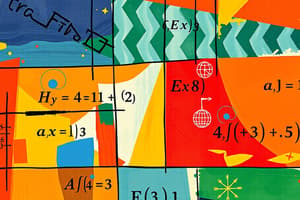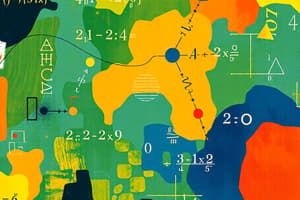Podcast
Questions and Answers
Which method can be used to solve a quadratic equation?
Which method can be used to solve a quadratic equation?
- Estimating using a number line
- Graphically, factoring, or using the quadratic formula (correct)
- Only through substitution
- By guessing the solutions
What does an exponent represent in mathematics?
What does an exponent represent in mathematics?
- Repeated addition of a number
- A variable substitution
- Sum of two numbers
- Repeated multiplication of a number (correct)
When solving a system of equations, what is required?
When solving a system of equations, what is required?
- Finding only the maximum value of the system
- Finding values for the variables that satisfy all equations (correct)
- Identifying which equation is incorrect
- Using only one method to solve
What is a key rule to remember when solving inequalities?
What is a key rule to remember when solving inequalities?
What describes the function of radicals in mathematics?
What describes the function of radicals in mathematics?
What is the purpose of performing the same operation on both sides of an equation?
What is the purpose of performing the same operation on both sides of an equation?
Which of the following correctly describes a polynomial?
Which of the following correctly describes a polynomial?
What characteristic defines a linear equation?
What characteristic defines a linear equation?
Which operation is NOT used to solve an equation?
Which operation is NOT used to solve an equation?
In the expression $3x^2 + 4x - 5$, what is the degree of the polynomial?
In the expression $3x^2 + 4x - 5$, what is the degree of the polynomial?
What is true about the y-intercept of a linear equation?
What is true about the y-intercept of a linear equation?
What type of equation is $x^2 - 5x + 6 = 0$ classified as?
What type of equation is $x^2 - 5x + 6 = 0$ classified as?
When factoring a polynomial, what does it mean to express it as a product of simpler polynomials?
When factoring a polynomial, what does it mean to express it as a product of simpler polynomials?
Flashcards
Quadratic Equation Solution Methods
Quadratic Equation Solution Methods
Quadratic equations can be solved graphically or algebraically (factoring, quadratic formula).
Exponents represent
Exponents represent
Repeated multiplication.
Radical Definition
Radical Definition
A symbol representing the root of a number.
System of Equations
System of Equations
Signup and view all the flashcards
Solving Inequalities
Solving Inequalities
Signup and view all the flashcards
Algebra
Algebra
Signup and view all the flashcards
Variable
Variable
Signup and view all the flashcards
Equation
Equation
Signup and view all the flashcards
Linear Equation
Linear Equation
Signup and view all the flashcards
Polynomial
Polynomial
Signup and view all the flashcards
Quadratic Equation
Quadratic Equation
Signup and view all the flashcards
Factoring
Factoring
Signup and view all the flashcards
Solving an Equation
Solving an Equation
Signup and view all the flashcards
Study Notes
Basic Algebraic Concepts
- Algebra is a branch of mathematics that uses letters and symbols to represent numbers and relationships between them.
- Variables are symbols (usually letters) that represent unknown values.
- Constants are numerical values that do not change.
- Expressions are combinations of variables, constants, and operations (like addition, subtraction, multiplication, and division).
- Equations are mathematical statements that show the equality of two expressions.
- Inequalities compare two expressions using symbols like < (less than), > (greater than), ≤ (less than or equal to), ≥ (greater than or equal to), or ≠ (not equal to).
Solving Equations
- The goal in solving an equation is to isolate the variable on one side of the equation.
- To solve an equation, you must perform the same operations to both sides of the equation.
- Inverse operations (addition and subtraction, multiplication and division) are used to isolate variables.
- Adding or subtracting the same value to both sides of an equation does not change the equality.
- Multiplying or dividing both sides of an equation by the same non-zero value does not change the equality.
Linear Equations
- A linear equation has the form ax + b = 0, where 'a' and 'b' are constants and 'x' is a variable.
- The graph of a linear equation is a straight line.
- The slope of a line represents the steepness and direction of the line.
- The y-intercept is the point where the line crosses the y-axis.
Polynomials
- Polynomials are algebraic expressions consisting of variables and coefficients, combined using addition, subtraction, and multiplication, but never division by a variable.
- The degree of a polynomial is the highest power of the variable in the expression.
- Polynomials can be single-term (monomials), two-term (binomials), three-term (trinomials), or more.
- Important operations on polynomials include addition, subtraction, multiplication, and division.
Factoring
- Factoring is the process of expressing a polynomial as a product of simpler polynomials.
- Common factors can be factored out of terms.
- Different factoring methods exist depending on the form of the polynomial, such as grouping, difference of squares, and quadratic factoring.
Quadratic Equations
- A quadratic equation is an equation of the form ax² + bx + c = 0, where 'a', 'b', and 'c' are constants and 'x' is a variable.
- Quadratic equations can be solved graphically or using algebraic methods like factoring or the quadratic formula.
Exponents and Radicals
- Exponents represent repeated multiplication.
- Radicals are used to represent roots of numbers; for example, the square root of a number, √x.
- Laws of exponents help simplify and manipulate expressions with exponents.
- There are specific arithmetic rules and properties for solving with exponents.
Systems of Equations
- A system of equations consists of two or more equations with the same variables.
- Solving a system of equations involves finding values for the variables that satisfy all the equations in the system.
- Different methods exist for solving systems of equations, such as graphing, substitution, and elimination.
Inequalities
- Inequalities are mathematical statements that use symbols like <, >, ≤, ≥, or ≠ to compare expressions.
- To solve inequalities, you follow similar rules as solving equations, but reversing the direction of the inequality sign when multiplying or dividing by a negative number.
Studying That Suits You
Use AI to generate personalized quizzes and flashcards to suit your learning preferences.




